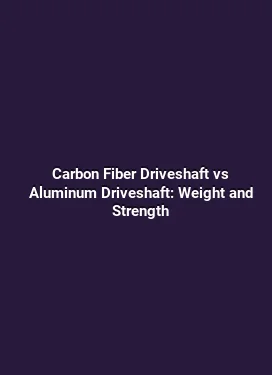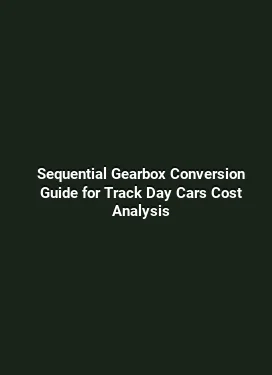The Future of Drivetrain: Electrification and AWD Systems
Makale içindeki ilk H2 başlık buraya gelmeli

The drivetrain landscape is undergoing a transformative shift driven by electrification, tighter emissions regulations, and evolving consumer expectations for performance and efficiency. Traditional mechanical linkages between the engine, transmission, and axles are being replaced or augmented by electric motors, software-defined control strategies, and modular architectures that enable scalable powertrains. In this transition, all-wheel drive (AWD) and advanced transmission concepts are not only adapting to new energy sources but also unlocking new levels of dynamic capability, safety, and user experience. This section provides a comprehensive overview of how electrification is reshaping drivetrain design, the roles of various components, and the tradeoffs engineers consider when mapping power to the road.
At the core of modern electrified drivetrains is the concept of distributed propulsion. Instead of a single power source driving the rear wheels or front wheels through a conventional transmission, multiple motors can deliver torque to different axles or even individual wheels. This distributed approach improves traction control, enables seamless all-weather performance, and supports advanced features such as torque vectoring and adaptive dampening. As a result, the drivetrain becomes a programmable system, capable of adjusting to road conditions, driver intent, and energy availability in real time. This dynamic behavior has meaningful implications for efficiency, handling, and ride quality, making it a central consideration in both performance and mainstream vehicles.
Integrated powertrains and modular architectures

One of the most significant shifts is toward integrated powertrain modules that combine electric motors, power electronics, and in some cases gear reduction within a compact unit. These modules can be placed on one or both axles, creating either front-, rear-, or all-wheel drive configurations without the bulky physical transmission found in internal combustion engine (ICE) vehicles. The modular approach supports scalable output, simplifies manufacturing, and reduces weight by consolidating components. For consumers, this can translate to more predictable torque delivery, quicker responses to throttle input, and enhanced stability during cornering or sudden changes in grip.
From a systems engineering perspective, the move toward modular electrified drivetrains necessitates sophisticated thermal management, electrical isolation, and software coordination. Heat generated by motors and power electronics must be dissipated efficiently to maintain performance and longevity, which in turn influences packaging decisions and overall vehicle efficiency. Meanwhile, software layers—ranging from motor control algorithms to high-level vehicle dynamics—coordinate power split between axles, respond to sensor data, and optimize energy usage across different driving modes. The result is a drivetrain that behaves like a single, intelligent entity rather than a collection of separate mechanical parts.
Emerging AWD Solutions in Electrified Platforms
All-wheel drive in the context of electrified platforms transcends traditional mechanical coupling. With independent motors on each axle or even on individual wheels, AWD becomes a dynamic, torque-vectoring system. Torque vectoring allows the system to distribute torque laterally between left and right wheels as well as longitudinally between front and rear axles. This capability improves cornering grip, yaw stability, and overall vehicle agility, especially in low-traction conditions. The practical effect is a vehicle that can maintain higher cornering speeds with greater composure and predictability.
Another trend is the ability to modulate torque distribution continuously rather than in discrete steps. Some systems use optimization algorithms that consider steering angle, vehicle speed, tire temperatures, road grade, and wheel-slip indicators to determine the ideal torque split in real time. This continuous control improves efficiency by limiting unnecessary slip and maximizes traction during launch or uphill climbs. In performance contexts, even small shifts in torque allocation can yield noticeable improvements in acceleration and handling precision, creating a more engaging driving experience while preserving safety margins.
Hybrid and plug-in architectures for AWD
Hybrid coordination introduces a spectrum of AWD configurations, from mild hybrids with a single motor driving one axle and internal combustion power handling the other, to full hybrids and plug-in hybrids with dual-motor, dual-axle arrangements. In plug-in hybrids, the electric drive can operate the vehicle in all-electric mode over short to moderate ranges, with the ICE engaged when higher power or extended range is required. This arrangement is particularly beneficial for urban driving where electric range suffices for typical commutes, while maintaining flexibility for longer trips. The AWD capability in these setups reinforces traction, especially in rain, snow, or uneven pavement, by leveraging electric torque to supplement the ICE-driven axle when necessary.
From a packaging standpoint, AWD in electrified vehicles often enables more compact drivetrains with fewer moving parts than a conventional ICE-based system with multiple clutches and gear sets. That reduction translates to lower maintenance costs and higher reliability, albeit with a reliance on high-voltage electrical systems that demand careful design, insulation, and safety considerations. Dealers and service technicians need to be conversant with motor cooling requirements, inverter maintenance, and diagnostic pathways for power electronics to keep AWD systems performing as intended over the vehicle’s lifetime.
Transmission Evolution in a Battery-Electric Era
The traditional automatic or manual transmission largely performs the function of converting engine torque into usable driving torque over a broad range of speeds. In battery-electric vehicles (BEVs), the motive power is delivered by electric motors with broad, flat torque curves. This changes the necessity and role of a multi-gear transmission. While some BEVs use single-gear reductions, others adopt two- or three-speed solutions or even sophisticated multi-speed gearboxes designed to optimize efficiency at highway speeds and provide strong off-the-line acceleration. The overarching trend is toward simplicity and efficiency, with gear ratio strategies tailored to motor characteristics and vehicle mission profile.
One practical consideration is the balance between weight, cost, and performance. A single-speed transmission keeps the drivetrain compact and reliable, but may require larger motor sizes to achieve desired acceleration. Conversely, multi-speed gearboxes can improve efficiency and acceleration but introduce complexity, weight, and potential reliability concerns. Automotive engineers mitigate these challenges by leveraging advanced materials, compact planetary gearsets, and integrated motor/gear designs that minimize parasitic losses. For the driver, the payoff is a vehicle that exhibits instant torque response at low speeds, smooth progression through gears at cruising speed, and improved overall efficiency in real-world driving conditions.
Continuously Variable Transmission (CVT) and its role
CVT-inspired approaches have influenced BEV and hybrid powertrains by enabling smooth, seamless torque delivery across a wide range of speeds. While traditional CVTs rely on belt-and-pulley systems, electrified variants often implement electronic controls and torque-aware strategies that emulate CVT behavior without the same mechanical complexity. The benefit is a refined driving experience with reduced gear-shifting artifacts and improved efficiency under varying load conditions. In performance-oriented platforms, however, some manufacturers opt for discrete gear steps or fixed-ratio solutions to preserve a heightened sense of immediacy and control, balancing driver engagement with efficiency goals.
From a maintenance perspective, electrified CVT-like systems tend to require careful thermal management and software calibration to prevent belt wear and ensure consistent torque delivery over the vehicle’s life. Service procedures increasingly include software updates, motor insulation checks, and battery health assessments as part of routine maintenance, reflecting the integrated nature of modern powertrains.
Power Electronics, Control Strategies, and Efficiency
At the heart of electrified drivetrains are the power electronics and control algorithms that govern motor performance, energy flow, and thermal behavior. In AWD configurations, the control system must orchestrate multiple motors, inverters, and electronic stability programs to deliver optimal traction and yaw control. Real-time data from wheel-speed sensors, gyroscopes, and tire telemetry informs the decision-making process, allowing the system to preempt slip and optimize energy use. The result is an AWD system that not only enhances safety and handling but also contributes to overall efficiency by preventing wasteful wheel slip during acceleration and cornering.
Thermal management becomes a central concern as power density increases. Efficient cooling of motors and inverters enables higher sustained power, longer component life, and better performance under demanding conditions. Advanced cooling strategies—such as liquid cooling, phase-change materials, and targeted airflow—are increasingly integrated into the drivetrain architecture. This emphasis on thermal performance is complemented by predictive maintenance models that anticipate component fatigue and schedule interventions before degraded performance manifests on the road.
Tire interaction and dynamic grip
Drivetrain design must account for the interface between tires and pavement. AWD systems can dynamically modulate torque to wheels with higher grip, but tire health and temperature significantly influence outcome. Modern platforms incorporate wear sensors and temperature monitors to adapt torque distribution in real time based on tire condition. This approach helps maintain consistent handling, reduces understeer or oversteer tendencies, and extends tire life by avoiding excessive slip. For enthusiasts, this translates into a drivetrain that feels more predictable and responsive, especially on damp or uneven surfaces where grip varies across the wheelplane.
In high-performance contexts, engineers also consider lateral torque vectoring as a means to enhance cornering stability without excessive steering input. By delivering precise amounts of torque to inner versus outer wheels, the system can reduce yaw rate and improve mid-corner stability, enabling higher cornering speeds with confidence. Such capabilities require tight calibration between sensors, actuators, and control software, underscoring the importance of a holistic approach to drivetrain development that blends hardware and software seamlessly.
Practical Implications for Maintenance and Ownership
Owners of electrified AWD platforms encounter a different maintenance landscape compared to conventional ICE vehicles. Routine service still emphasizes braking systems, cooling systems, and suspension components, but the drivetrain requires additional attention to battery health, inverter reliability, and motor cooling. Regular software updates are a normal part of ownership, delivering improvements in efficiency, torque control, and driving dynamics without hardware changes. It is advisable for consumers to service vehicles at authorized centers where technicians have access to calibration tools and updated diagnostic protocols for power electronics and motor systems.
Diagnostics increasingly rely on remote data access and onboard fault codes that can pinpoint issues within the electric drive system. A proactive maintenance approach—driven by remote monitoring and predictive analytics—helps prevent escalations into more costly repairs. Practical steps include monitoring thermal cycles, ensuring proper coolant levels, and paying attention to unusual motor sounds or vibrations that may indicate overheating or bearing wear. Thorough understanding of the drivetrain’s behavior in different modes, such as Eco or Sport, can also help drivers maximize efficiency and performance while protecting components over time.
Trend-Driven Semantics: How Language and Perception Drive Innovation
As propulsion architectures evolve, the terminology used to describe them also shifts. A focus on distributed propulsion, energy management, and torque vectoring reflects a broader move toward software-defined performance and intelligent control. Consumers associate electrified drivetrains with effortless acceleration, smoother power delivery, and enhanced safety features, while engineers emphasize reliability, thermal resilience, and system integration. This convergence in perception and reality fuels rapid innovation, guiding both product planning and consumer education. Understanding these semantic shifts can help readers interpret automotive developments more accurately and identify which features align with their priorities—efficiency, performance, or resilience in adverse conditions.
From the standpoint of market trends, electrified AWD is becoming a differentiator in segments ranging from compact EVs to high-performance electrics. The ability to deliver traction at multiple points on the vehicle with precise, responsive control remains a critical attribute for luxury and performance models, while mainstream offerings benefit from improved safety and user experience without compromising efficiency. The ongoing balance between weight, cost, and capability continues to shape the evolution of transmission and drivetrain architectures in the electrified era.
Concluding Thoughts: A Cohesive Vision for the Drivetrain of Tomorrow
The future drivetrain is characterized by electrification, modular architectures, and intelligent AWD systems that combine torque management with robust thermal and software engineering. The emphasis on integrated powertrains, multi-motor configurations, and adaptive control strategies creates a cohesive platform capable of delivering both efficiency and excitement. For engineers, the challenge lies in optimizing packaging, cooling, and software coordination to unlock the full potential of these advanced systems. For drivers, the payoff is a vehicle that offers smoother, more predictable power delivery, superior traction in diverse conditions, and a driving experience that feels both responsive and refined, regardless of the road surface or weather. As electrification continues to mature, the drivetrain will remain a critical frontier where hardware, software, and human factors converge to redefine what is possible on four wheels. Frequently Asked Questions






